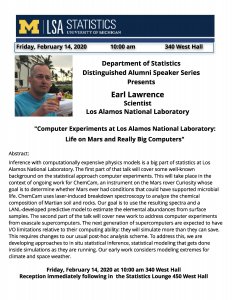Presented By: Department of Statistics
Distinguished Alumni Speaker Series: Earl Lawrence, Statistical Sciences, Los Alamos National Laboratory
"Computer Experiments at Los Alamos National Laboratory: Life on Mars and Really Big Computers"

Abstract:
Inference with computationally expensive physics models is a big part of statistics at Los Alamos National Laboratory. The first part of that talk will cover some well-known background on the statistical approach computer experiments. This will take place in the context of ongoing work for ChemCam, an instrument on the Mars rover Curiosity whose goal is to determine whether Mars ever had conditions that could have supported microbial life. ChemCam uses laser-induced breakdown spectroscopy to analyze the chemical composition of Martian soil and rocks. Our goal is to use the resulting spectra and a LANL-developed predictive model to estimate the elemental abundances from surface samples. The second part of the talk will cover new work to address computer experiments from exascale supercomputers. The next generation of supercomputers are expected to have I/O limitations relative to their computing ability: they will simulate more than they can save. This requires changes to our usual post-hoc analysis scheme. To address this, we are developing approaches to in situ statistical inference, statistical modeling that gets done inside simulations as they are running. Our early work considers modeling extremes for climate and space weather.
Inference with computationally expensive physics models is a big part of statistics at Los Alamos National Laboratory. The first part of that talk will cover some well-known background on the statistical approach computer experiments. This will take place in the context of ongoing work for ChemCam, an instrument on the Mars rover Curiosity whose goal is to determine whether Mars ever had conditions that could have supported microbial life. ChemCam uses laser-induced breakdown spectroscopy to analyze the chemical composition of Martian soil and rocks. Our goal is to use the resulting spectra and a LANL-developed predictive model to estimate the elemental abundances from surface samples. The second part of the talk will cover new work to address computer experiments from exascale supercomputers. The next generation of supercomputers are expected to have I/O limitations relative to their computing ability: they will simulate more than they can save. This requires changes to our usual post-hoc analysis scheme. To address this, we are developing approaches to in situ statistical inference, statistical modeling that gets done inside simulations as they are running. Our early work considers modeling extremes for climate and space weather.